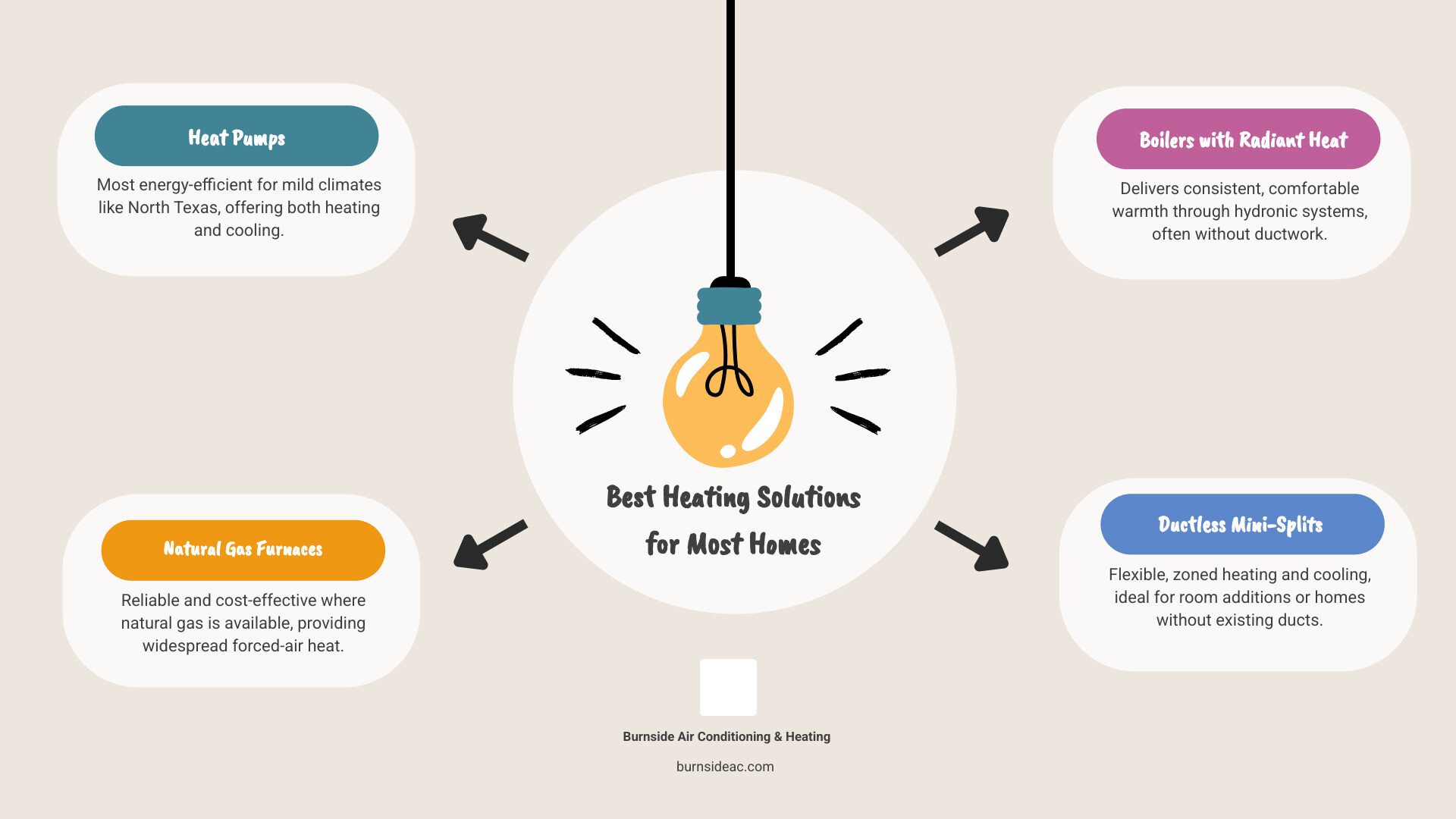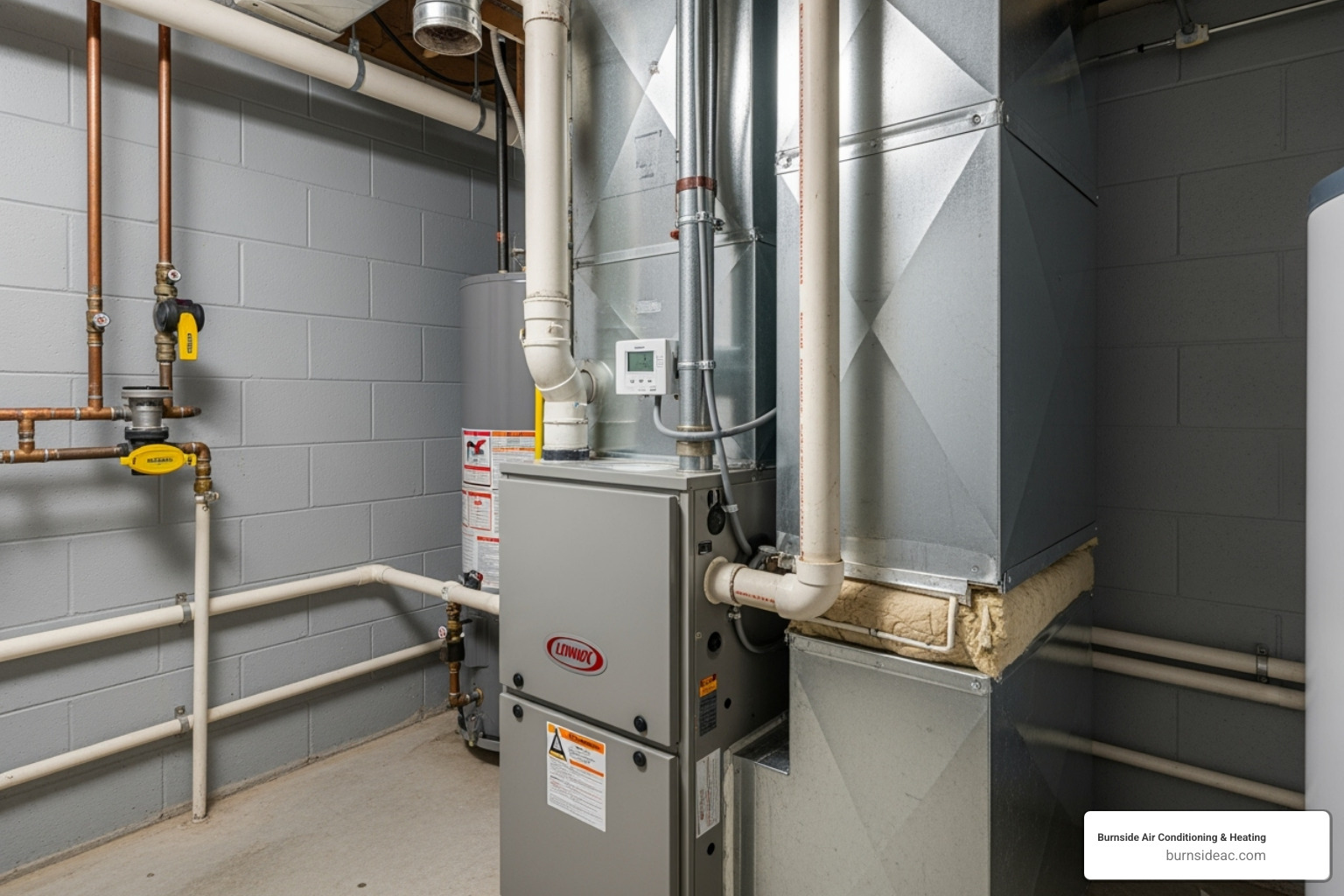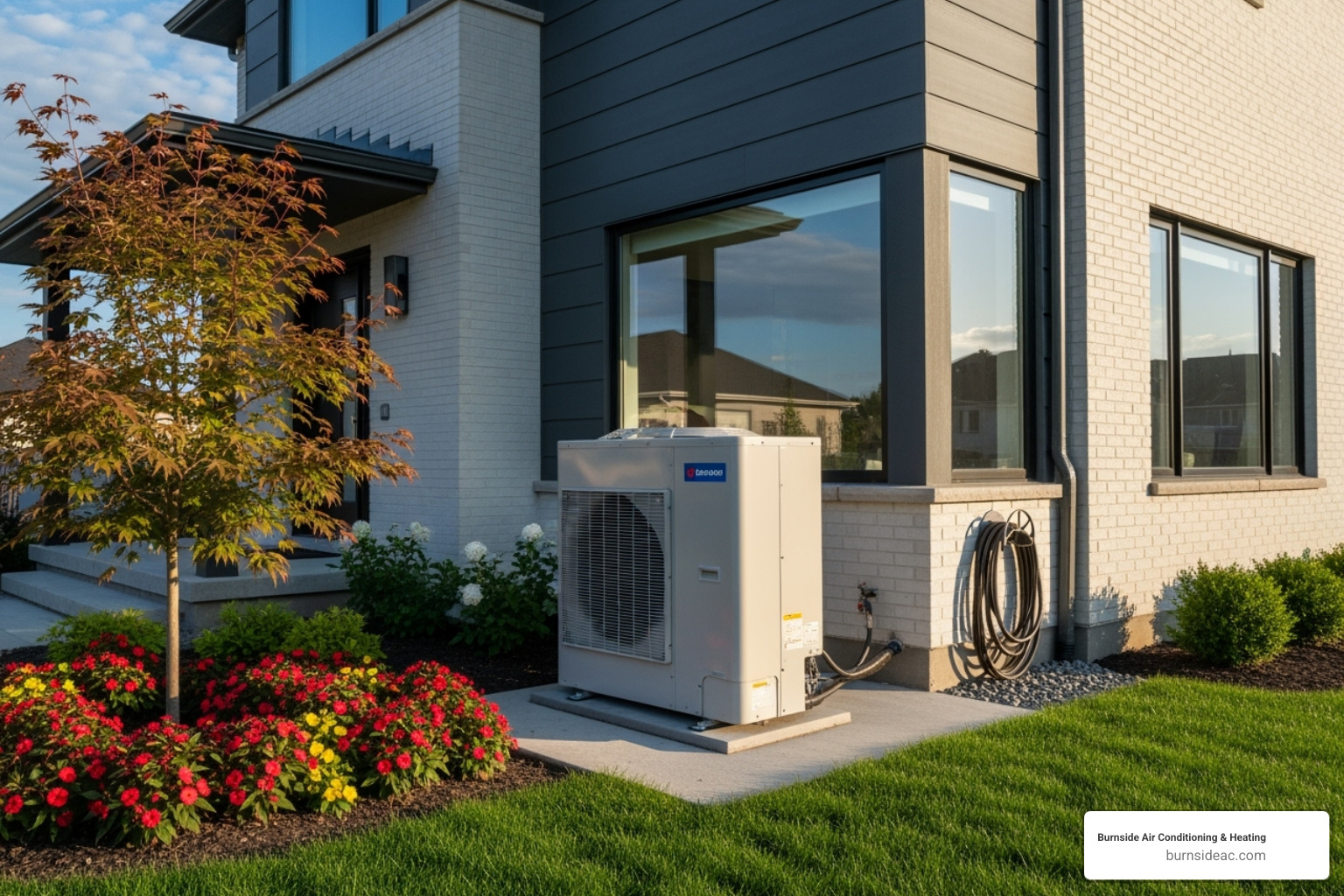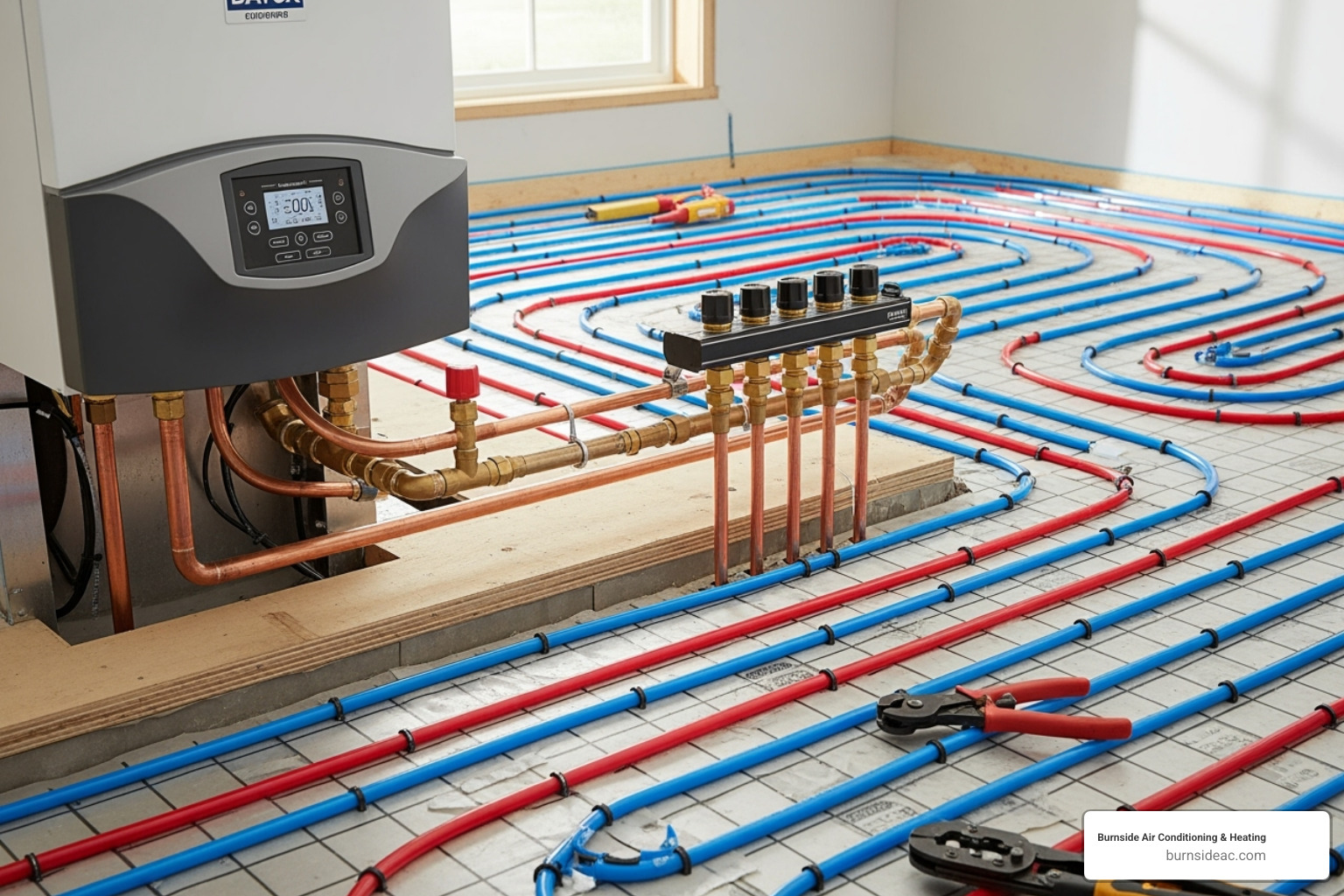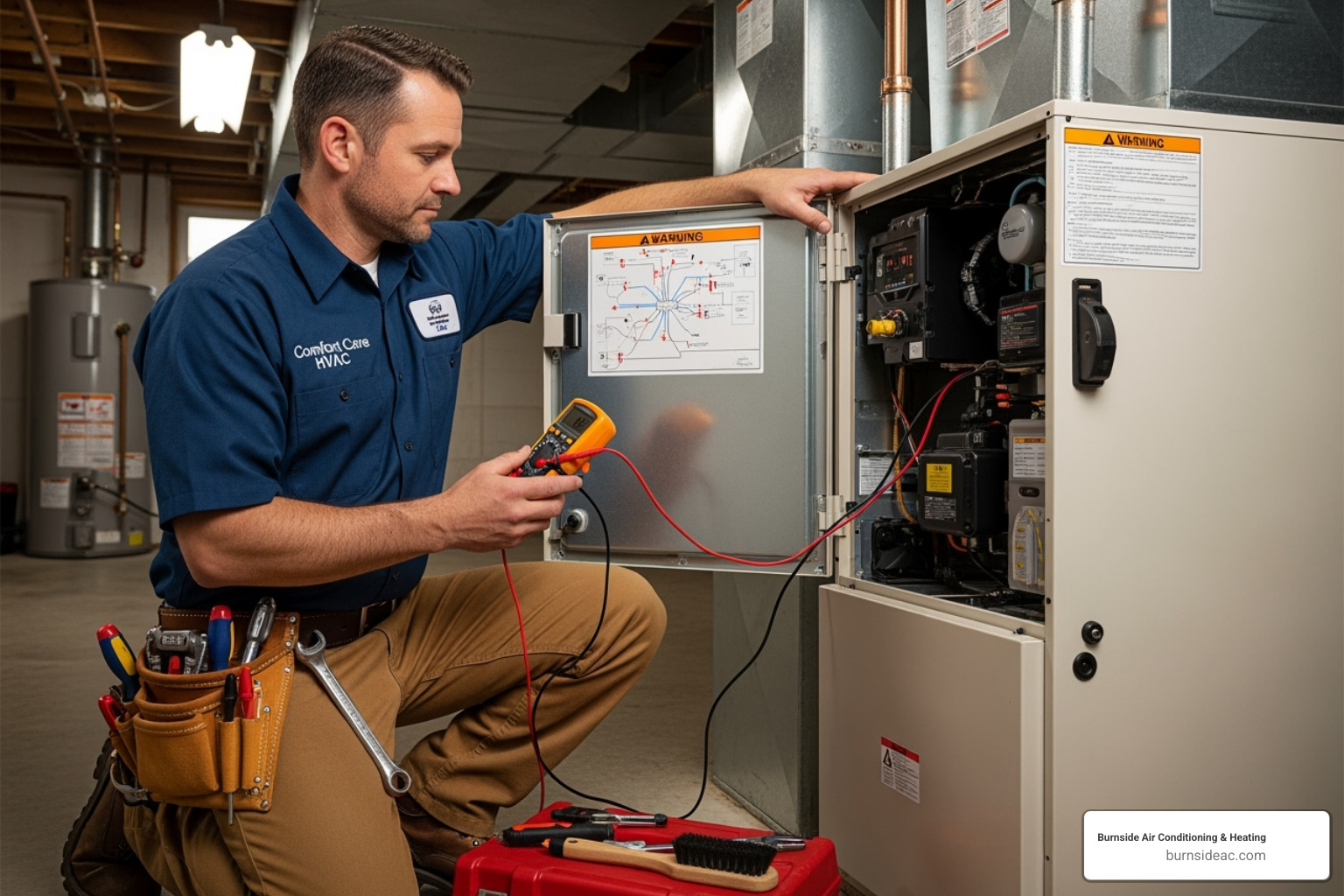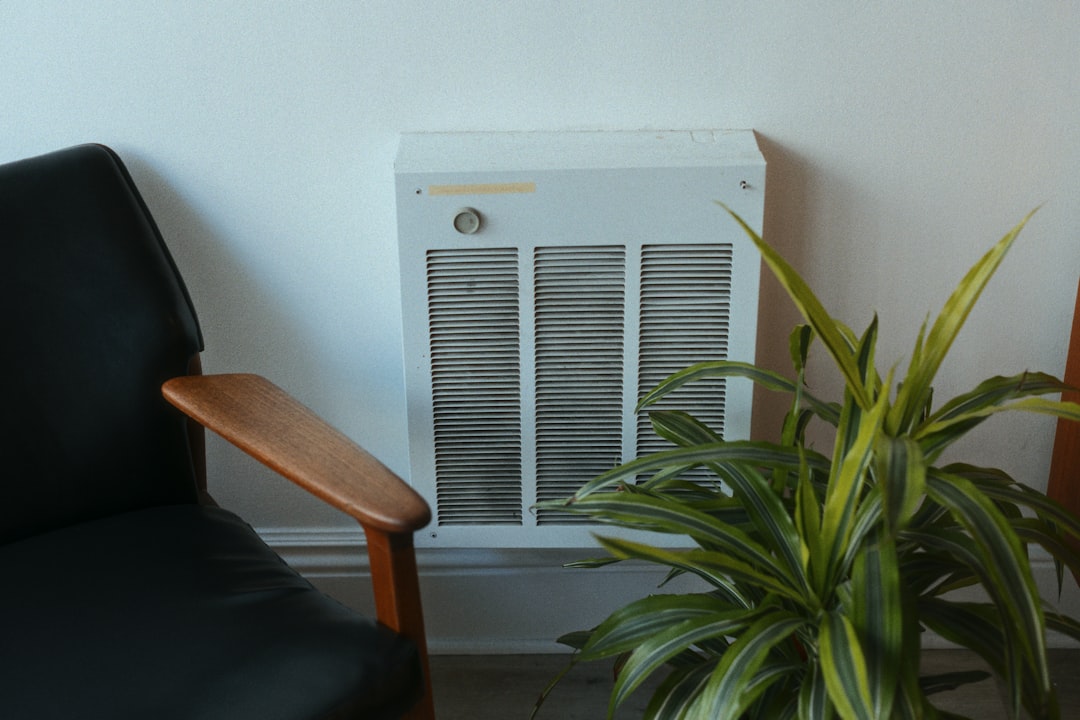
Why Choosing the Right Heating Solution Matters for Your Home
Best heating solution selection can dramatically impact your comfort, energy bills, and peace of mind during Texas winters. With heating typically accounting for about 29% of your utility bill, making the right choice isn’t just about staying warm—it’s about smart home investment.
Quick Answer: The Best Heating Solutions for Most Homes:
- Heat Pumps – Most energy-efficient for mild climates like North Texas
- Natural Gas Furnaces – Reliable and cost-effective where gas is available
- Boilers with Radiant Heat – Consistent comfort without ductwork
- Ductless Mini-Splits – Perfect for room additions or older homes
The good news? You can save about 30% on your energy bill by combining the right heating equipment with proper maintenance and home improvements like insulation and air sealing.
But here’s what many homeowners don’t realize: there’s no single “best” heating solution for every home. Your ideal system depends on your home’s size, insulation quality, local climate, and available fuel sources. A 950-square-foot well-insulated home in McKinney might thrive with a ductless mini-split, while a larger family home could benefit from a high-efficiency gas furnace.
“One of the biggest changes I have to adapt to after moving to Colorado is the need for heat,” shared one homeowner in our research. This perfectly captures why choosing the right heating solution matters—you want a system that works reliably when you need it most.
The key is taking a whole-house approach. Your heating system works best when paired with proper insulation, sealed air leaks, and smart thermostat settings. This guide will walk you through every major heating option, help you compare costs and efficiency, and give you the knowledge to make the best decision for your specific situation.
Understanding the Most Common Home Heating Systems
Finding the best heating solution for your home starts with understanding your options. Each system offers unique benefits, from quick response to steady, even warmth. Let’s explore the most popular choices.
Furnaces (Forced-Air Systems)
Furnaces are the most common heating systems in the United States because they are reliable and versatile. These workhorses are typically found in a basement or utility room.
Forced-air systems pull cold air into the furnace, warm it with a heat exchanger using natural gas, propane, oil, or electricity, and then a blower pushes the warm air through ductwork to vents throughout your home.
Furnaces are popular because they heat homes quickly and are versatile, using the same ductwork for both heating and air conditioning. This integration makes a central heating system a cost-effective choice for year-round comfort. You can also easily add filters, humidifiers, and air purifiers to the ductwork. The main downside is that installation can be complex if your home lacks existing ductwork, and some find the forced air can feel dry.
AFUE ratings measure furnace efficiency—a higher AFUE means lower energy bills. Modern furnaces can last 15-20 years with proper care, making them a solid long-term investment.
If you’re dealing with furnace troubles, check out our guide on Common Furnace Issues and Our Solutions. Ready for a new system? Our Furnace Installation page has everything you need to know.
Heat Pumps
Heat pumps are clever systems that don’t create heat; they move it. They extract warmth from the outside air—even on cold days—and transfer it into your home.
Heat pumps are the ultimate multitaskers, providing heating and cooling in one system. In winter, they bring heat indoors. In summer, they reverse the process, pulling heat from inside and moving it outdoors.
Air-source heat pumps are the most common, using either traditional ductwork or operating as ductless mini-splits. Geothermal systems use the earth’s stable underground temperatures, making them highly efficient but with a larger upfront investment.
Heat pumps are exceptionally efficient because they move heat rather than generating it. They are also quiet and environmentally friendly, making them ideal for North Texas’s mild winters. The main challenge is that traditional models can struggle in very low temperatures, though modern units have improved significantly.
Efficiency is measured by HSPF (heating) and SEER (cooling) ratings. Higher numbers mean lower energy bills. Air-source heat pumps last 15-20 years, while geothermal systems can last 20-25 years.
Want to dive deeper? Check out this excellent resource on Heating and Cooling With a Heat Pump. If you’re considering making the switch, our team can help with Heat Pump Installation for Your Home.
Boilers and Radiant Heat
Boilers provide luxurious, steady warmth through hydronic heating (hot water), creating a unique comfort experience.
The boiler heats water and pumps it through pipes to radiators, baseboard heaters, or in-floor radiant heat systems. Instead of blowing air, these systems warm the surfaces in your room for incredibly even, consistent heat.
Radiant floor heating is the gold standard of comfort, warming floors for an even heat from the ground up without drafts. Hydronic systems are also silent and don’t require ductwork, making them great for older homes. They also don’t circulate dust or dry out the air. The trade-off is a slower response time to thermostat changes, and you’ll need a separate system for air conditioning.
Modern boilers last 15-20 years, while radiant floor systems can last 30-40 years or more, making them an excellent long-term investment.
Planning a heating upgrade? Our guide on What to Expect During a Heating Installation walks you through the entire process.
Other Heating Technologies
Beyond the big three, other options serve specific needs:
- Ductless mini-split systems are heat pumps that don’t need ductwork, perfect for room additions or older homes. They allow for independent temperature control in different zones.
- Electric resistance heating (baseboard heaters, wall units) is inexpensive to install but typically expensive to operate due to electricity costs. The U.S. Department of Energy explains more about Electric Resistance Heating.
- Wood stoves offer charm and off-grid warmth but require manual labor for fueling and cleaning.
- Solar heating uses the sun’s energy, offering zero operating costs but requiring a significant upfront investment and a backup system.
Knowing when to replace your system is crucial. Our guide on Signs You Need a Heating Replacement Service can help you spot the warning signs.
How to Choose the Best Heating Solution for Your Home
Selecting the best heating solution requires careful planning. The right system will keep you comfortable while being kind to your wallet, but the perfect choice depends on your specific home and needs.
Key Factors to Consider Before You Buy
Before choosing a system, assess your home’s specific requirements.
- Home size and layout: A small, open-plan home might only need a single heat pump, while a large, multi-story home could benefit from zoned heating offered by ductless mini-splits or hydronic systems.
- Insulation quality and air sealing: This is critical. Even the most advanced heating system will struggle in a leaky, poorly insulated home. A well-sealed home can use a smaller, more efficient system, saving up to 30% on energy bills when the right equipment is paired with good insulation.
- Local climate: In North Texas, our mild winters make heat pumps an excellent choice. Harsher climates often require a robust furnace or a hybrid system.
- Fuel availability and costs: If you have natural gas access, a gas furnace is often the most economical choice. Without a gas line, propane delivery or electricity are alternatives. While heat pumps use electricity efficiently, electric resistance heating is typically the most expensive to operate.
- Installation vs. operating costs: Some systems, like geothermal, have a high upfront cost but save you money over time with lower operating expenses. Others, like electric baseboard heaters, are cheap to install but expensive to run. Find the balance that fits your budget and long-term goals.
Comparing Costs to Find the Best Heating Solution
Costs vary by home, but here is a general comparison of key financial factors.
- Installation costs: Forced-air systems and heat pumps have similar installation costs. Radiant floor and boiler systems vary widely, especially in retrofits. Ductless mini-splits offer flexible pricing since you can add zones over time. Electric resistance heating has the lowest upfront cost.
- System longevity: Most heating systems last 15-25 years with proper maintenance. Components of geothermal and radiant floor systems can last for decades, justifying their higher initial cost.
- Operating costs: Since heating is about 29% of a typical utility bill, efficiency matters. Geothermal heat pumps are often the most economical to run long-term. Natural gas furnaces strike a good balance between installation and operating costs, while electric resistance heating is generally the most expensive to operate.
Consider the total cost of ownership over the system’s lifespan, not just the initial price tag.
What is the Best Heating Solution for Different Climates?
Your local climate is a primary factor in choosing the right heating system.
- Cold climates: For harsh winters, high-efficiency furnaces (especially natural gas) provide powerful, reliable heat. Hybrid systems, which pair a heat pump with a furnace, are also a smart choice. Ground-source heat pumps and boiler systems with radiant heat offer superior comfort in prolonged cold.
- Mild climates: For regions like North Texas, air-source heat pumps are often the best heating solution. They provide efficient heating in winter and act as an air conditioner in summer. Natural gas furnaces remain a solid choice, and ductless mini-splits are excellent for zoned temperature control.
The difference between humid and dry regions also matters. Forced-air systems can dry out the air (fixable with a humidifier), while hydronic systems don’t affect humidity.
The bottom line is that a professional assessment is the best way to determine the ideal system for your home. Our team understands the climate challenges in Collin County and can provide expert guidance on Heat Pump Service and other systems suited to our area.
Maintaining Your System for Peak Performance
No matter which best heating solution you’ve chosen, proper maintenance is essential to ensure it runs efficiently and reliably for years. Most homeowners only think about their system when it fails, but proactive care prevents this, saving you from years of lower efficiency and higher bills.
The Importance of Routine Maintenance
Spending a little on upkeep can save you hundreds of dollars and prevent emergency repair calls.
- Energy efficiency: A well-maintained system uses less energy. Dirty filters, coils, and struggling parts force the system to work harder, which increases your utility bills.
- System lifespan: Regular care can significantly extend your system’s life. A neglected furnace might fail years early, while a well-maintained one can last for 25 years or more.
- Safety inspections: This is critical for gas or oil systems. Technicians check for carbon monoxide leaks, cracked heat exchangers, and faulty safety controls to protect your family.
- Preventing breakdowns: Most major failures start as small issues. A trained technician can spot early warning signs during routine maintenance, preventing expensive emergency repairs.
We’ve learned that Why Routine Heating Maintenance Matters is about giving families confidence that their home will stay warm and safe all winter.
DIY Maintenance vs. Professional Tune-Ups
You can perform simple tasks to help your system, but some jobs are best left to professionals.
DIY Tasks:
- Change air filters: A clogged filter makes your system work harder. Check filters monthly and replace them every 1-3 months, or more often if you have pets or allergies.
- Clear vents and radiators: Ensure furniture, curtains, or other items are not blocking airflow from vents, radiators, or baseboard heaters.
- Clean around outdoor units: If you have a heat pump, keep the area around the outdoor unit clear of leaves and debris (at least two feet of clearance). Gently hose off the coils after turning off the power.
- Check thermostat settings: Ensure your thermostat is set to “heat” and consider a programmable or smart thermostat to optimize energy use.
Professional Tune-Ups:
While DIY tasks help, professional service is more thorough. A technician will check electrical connections, gas pressures, refrigerant levels, and heat exchanger integrity. They can spot hidden problems and make fine-tuned adjustments for peak performance. During a service, we inspect and clean internal components, test safety controls, and check for gas or carbon monoxide issues to ensure your system is safe and efficient.
We believe a Heating Tune-Up Essential Before Winter prepares you for a worry-free season. If a problem does arise, our team is ready to help with Heating Repair services.
Frequently Asked Questions about Home Heating
Homeowners in McKinney and Collin County often ask the same thoughtful questions about heating. Understanding the basics helps you make smarter decisions. Here are the most common questions we hear.
What is HVAC?
HVAC stands for Heating, Ventilation, and Air Conditioning. It’s the complete, integrated system responsible for your home’s year-round climate control.
- Heating keeps you warm in the winter.
- Ventilation circulates air, removing stale air and bringing in fresh air.
- Air Conditioning cools your home in the summer.
These components often work together. For example, your furnace and air conditioner may share the same ductwork, creating an efficient, all-in-one system for home comfort.
What is the most common type of heating system in the U.S.?
Forced-air systems that use furnaces are the most popular heating choice in America. Their popularity stems from versatility and practicality; they use the same ductwork for both heating and AC, making them a cost-effective, integrated solution for year-round comfort. This widespread integration has made forced-air the go-to choice for builders and homeowners.
What is the most energy-efficient heating system?
The most energy-efficient heating system is the geothermal heat pump. It uses the earth’s stable underground temperatures to heat and cool your home with unparalleled efficiency. While the upfront cost is high, their low operating costs and long lifespan make them excellent long-term investments.
Other highly efficient options include:
- Active solar heating: This system uses free energy from the sun, though a backup system is usually needed for cloudy days.
- Radiant floor heating: This method is very efficient because it delivers heat directly from the floor up, minimizing the energy losses associated with ductwork.
- Air-source heat pumps: Modern models are highly efficient and perform beautifully in mild winters like ours in North Texas, while also providing summer cooling.
You can learn more from the U.S. Department of Energy’s guide on Geothermal Heat Pumps.
The best heating solution for efficiency ultimately depends on your home, climate, and budget, but these systems consistently deliver the most heat per dollar spent on energy.
Conclusion
Finding the best heating solution for your home doesn’t have to be overwhelming. Throughout this guide, we’ve walked through the most popular heating options available today—from the widespread reliability of furnaces and the dual-season efficiency of heat pumps to the luxurious comfort of boiler systems with radiant heat.
What we hope you’ve finded is that there’s no universal “winner” when it comes to home heating. Your best heating solution depends on your unique situation. A well-insulated ranch home in McKinney might thrive with an energy-efficient heat pump, while a larger two-story home could benefit from a high-efficiency gas furnace with zoned ductwork.
The key factors we’ve covered—your home’s size and insulation quality, our North Texas climate, available fuel sources, and your budget for both installation and long-term operation—all work together to point you toward the right choice. You can potentially save about 30% on your energy bills by pairing the right equipment with proper home sealing and insulation.
This is exactly why we always recommend starting with a professional home assessment. Every home tells a different story, and what works perfectly for your neighbor might not be ideal for your family’s needs and lifestyle.
At Burnside Air Conditioning & Heating, we’ve been helping families in McKinney and throughout Collin County stay comfortable since 1958. As a family-owned business, we understand that your home is your sanctuary, and choosing a heating system is about more than just equipment—it’s about ensuring your family’s comfort for years to come.
Our team takes the time to understand your home’s unique characteristics, your comfort preferences, and your budget goals. We provide honest assessments, flat-rate pricing, and guaranteed workmanship because we believe you deserve reliable service you can trust.
Whether you’re considering a heat pump upgrade, need a furnace replacement, or want to explore radiant heating options, we’re here to guide you through every step of the process. For expert advice and professional furnace replacement in McKinney, TX, contact our team today. Let’s work together to find your perfect heating solution.
